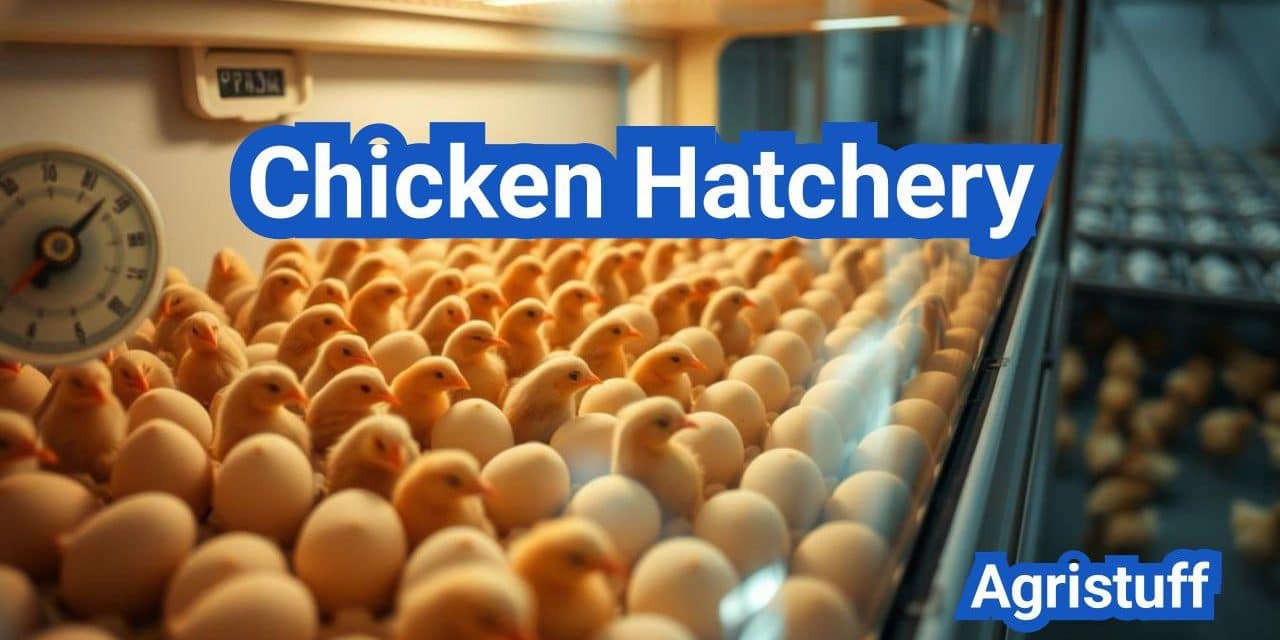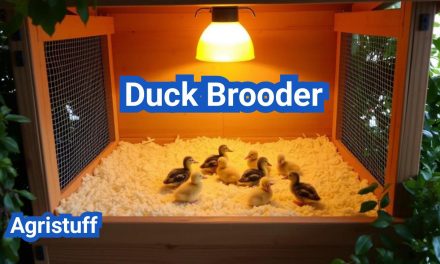Operating a successful chicken hatchery requires careful planning, precise management, and a deep understanding of poultry egg incubation. The poultry industry relies heavily on efficient hatchery management to meet the growing demand for poultry products.
A well-managed hatchery is crucial for the production of high-quality chicks, which is essential for the overall success of the poultry industry. According to industry experts, the development of the poultry industry is closely tied to the advancements in hatchery management techniques.
Key Takeaways
- Efficient hatchery management is crucial for the poultry industry.
- A well-planned chicken hatchery business plan is essential for success.
- Poultry egg incubation requires precise temperature and humidity control.
- Proper sanitation and hygiene practices are vital in a hatchery.
- Regular monitoring and maintenance ensure optimal hatchery performance.
The Fundamentals of Chicken Hatchery Operations
Modern chicken hatcheries are complex facilities that require precise control over various factors to ensure successful hatching. The efficiency of these operations is crucial for meeting the demand for chicken products in the poultry industry.
Evolution of Modern Hatchery Practices
The chicken hatchery industry has undergone significant transformations over the years, driven by advances in technology and changing consumer demands. Modern hatcheries now utilize sophisticated chicken hatchery machines and poultry breeding systems to optimize the hatching process.
One of the key advancements in hatchery technology is the development of advanced incubation systems. These systems allow for precise control over temperature, humidity, and egg turning, which are critical factors in determining hatchability and chick quality. For instance, maintaining an ideal embryo temperature between 37.5°C and 38.3°C is crucial for optimal hatchability and chick quality.
Types of Hatchery Operations
Commercial chicken hatcheries vary in their operations and specialties. Some focus on producing chicks for the broiler market, while others specialize in layers or breeders. Understanding the different types of hatchery operations is essential for developing effective business strategies.
| Type of Hatchery | Specialization | Key Characteristics |
|---|---|---|
| Broiler Hatcheries | Producing chicks for meat production | High-volume production, focused on growth rate and feed efficiency |
| Layer Hatcheries | Producing chicks for egg production | Focused on egg-laying capacity, often using specific breeds known for high egg production |
| Breeder Hatcheries | Producing parent stock for other hatcheries | Emphasis on genetic selection and improvement programs |
The diversity in hatchery operations highlights the complexity and specialization within the industry. As the demand for poultry products continues to evolve, hatcheries must adapt by leveraging the latest technologies and breeding strategies.
Developing a Comprehensive Hatchery Business Plan
A comprehensive business plan is crucial for the success of a chicken hatchery, encompassing market analysis, financial forecasting, and regulatory compliance. This plan serves as a roadmap for the hatchery’s operations, guiding decision-making and strategic development.
Market Analysis and Target Customer Identification
Conducting a thorough market analysis is the first step in creating a hatchery business plan. This involves understanding the demand for chicks, identifying target customers such as poultry farmers and backyard chicken keepers, and analyzing competitors. Market research helps in determining the optimal production volume and pricing strategy.
For instance, understanding the seasonal fluctuations in demand can help hatcheries adjust their production schedules accordingly. Identifying niche markets, such as breeders of heritage or specialty chickens, can also provide opportunities for differentiation and premium pricing.
Financial Projections and Funding Sources
Financial projections are a critical component of the business plan, outlining expected revenues, expenses, and profitability. This includes estimating costs for equipment, facilities, labor, and marketing, as well as projecting income from chick sales. Accurate financial forecasting helps in securing funding, whether through investors, loans, or grants.
Exploring various funding sources is essential for hatchery startups. Options may include agricultural loans, government subsidies for sustainable practices, or private investment from individuals interested in the poultry industry.
Regulatory Compliance and Certification Requirements
Compliance with regulatory standards is vital for the operation of a chicken hatchery. This includes adhering to biosecurity measures, animal welfare standards, and environmental regulations. Obtaining necessary certifications, such as those related to salmonella control or organic production, can also enhance marketability and compliance with customer requirements.
Understanding and implementing these regulations not only ensures legal operation but also contributes to the overall sustainability and reputation of the hatchery. Regular audits and training for staff are essential components of maintaining compliance.
Designing an Efficient Chicken Hatchery Facility

A well-designed chicken hatchery is essential for maximizing hatch rates and chick quality. The design of the facility influences various aspects of hatchery operations, from incubation to chick processing. A comprehensive design considers factors such as layout, environmental control, and utility requirements to ensure optimal conditions for hatching.
Optimal Layout and Workflow Considerations
The layout of a chicken hatchery should facilitate a smooth workflow, minimizing the risk of contamination and ensuring efficient movement of eggs and chicks through the facility. High ceilings, typically around 3.1 m (10 ft), are recommended to accommodate forced-draft ventilation systems, which are crucial for maintaining a consistent environment.
Environmental Control Systems
Environmental control systems are vital for maintaining optimal conditions within the hatchery. This includes temperature control, humidity management, and ventilation. Advanced systems can automatically adjust these parameters to ensure they remain within the required ranges, thereby enhancing hatchability and chick health.
Utility Requirements and Backup Systems
Hatcheries require reliable utility services, including electricity, water, and gas. Backup systems, such as generators and UPS units, are essential for ensuring continuous operation during power outages. Additionally, water treatment systems may be necessary to ensure a consistent supply of clean water.
Essential Equipment for Modern Chicken Hatcheries
Advanced technology and specialized machinery are crucial for efficient chicken hatchery operations. Modern chicken hatcheries rely on a range of equipment to manage the incubation process, handle eggs, and process chicks.
Incubation Systems and Technologies
Incubation systems are the backbone of any chicken hatchery. These systems are designed to provide optimal conditions for egg incubation, including temperature control, humidity management, and egg turning. Modern incubation systems often feature advanced technologies such as computerized controls and automated egg turning.
The choice of incubation system can significantly impact hatch rates and chick quality. Single-stage and multi-stage incubators are the two primary types used in commercial hatcheries. Single-stage incubators provide a uniform environment for all eggs, while multi-stage incubators accommodate eggs at different stages of incubation.
Egg Handling and Processing Equipment
Efficient egg handling equipment is essential for maintaining egg integrity and reducing labor costs. This includes egg washers, egg sorters, and egg candling machines. Egg washers clean eggs to prevent contamination, while egg sorters categorize eggs by size and quality. Egg candling machines help identify fertile eggs and detect any abnormalities.
Chick Processing and Sexing Tools
Chick processing involves a series of steps including sexing, vaccination, and packaging. Modern chick processing equipment includes automated sexing machines and vaccination systems. These tools help reduce labor costs and improve the accuracy of chick processing.
| Equipment Type | Function | Benefits |
|---|---|---|
| Incubation Systems | Control temperature, humidity, and egg turning | Improved hatch rates, reduced labor |
| Egg Handling Equipment | Clean, sort, and inspect eggs | Enhanced egg quality, reduced contamination |
| Chick Processing Equipment | Sex, vaccinate, and package chicks | Increased efficiency, improved chick health |
Implementing Effective Poultry Breeding Systems

Effective poultry breeding systems are crucial for the success of modern chicken hatcheries. These systems encompass a range of practices and technologies designed to improve the productivity, health, and genetic quality of poultry.
Breeding Flock Management
Breeding flock management is a critical component of poultry breeding systems. It involves the careful selection, maintenance, and monitoring of the breeding stock to ensure optimal reproductive performance. Efficient flock management includes providing appropriate nutrition, health care, and living conditions to maximize fertility and hatchability.
Effective breeding flock management also requires regular health checks and vaccinations to prevent disease outbreaks that could impact fertility and overall flock health.
Genetic Selection and Improvement Programs
Genetic selection is a key aspect of poultry breeding, focusing on identifying and breeding birds with desirable traits such as high growth rates, improved feed conversion, and enhanced disease resistance. Genetic improvement programs utilize advanced techniques like genomic selection to accelerate progress in these areas.
These programs involve systematic data collection on bird performance, pedigree analysis, and the application of statistical models to predict breeding values. By leveraging this information, breeders can make informed decisions to enhance the genetic quality of their flocks.
Crossbreeding Strategies for Commercial Production
Crossbreeding is a common practice in commercial poultry production, aimed at exploiting hybrid vigor to improve performance traits. Crossbreeding strategies involve mating birds from different genetic lines or breeds to produce offspring that combine the beneficial characteristics of both parents.
The success of crossbreeding programs depends on careful selection of parent lines, considering factors such as compatibility, genetic diversity, and the specific traits desired in the offspring. By implementing effective crossbreeding strategies, producers can achieve significant gains in productivity and efficiency.
Mastering Fertile Egg Collection and Storage
Fertile egg collection and storage require meticulous attention to detail to ensure high hatch rates. The process begins with understanding the optimal timing and methods for collecting fertile eggs.
Optimal Collection Timing and Methods
The timing of egg collection is critical. Eggs should be collected frequently, ideally every hour, to prevent damage and reduce the risk of contamination. The method of collection is also important; eggs should be handled gently to avoid cracks and breaks.
Best Practices for Egg Collection:
- Collect eggs frequently to prevent damage.
- Handle eggs gently to avoid cracks.
- Use clean, dry containers for egg storage during collection.
Egg Evaluation and Selection Criteria
Not all collected eggs are suitable for incubation. Eggs should be evaluated based on cleanliness, shape, and size. Dirty or cracked eggs should be removed from the incubation process.
Egg Evaluation Criteria:
| Criteria | Description | Acceptable Standard |
|---|---|---|
| Cleanliness | Presence of dirt or stains | Clean, minimal staining |
| Shape | Regular or irregular shape | Regular shape |
| Size | Weight or dimensions | Average size for breed |
Storage Conditions for Maximum Viability
Proper storage conditions are crucial for maintaining egg viability. Eggs should be stored in a cool, humid environment. According to industry insights, “excessive moisture loss from eggs during storage can produce the same symptoms as low humidity in the machines.”
Ideal Storage Conditions:
- Temperature: 55-60°F (13-15°C)
- Humidity: 70-80%
- Position: Large end up
By mastering fertile egg collection and storage, hatcheries can significantly improve hatch rates and overall productivity. It’s a critical step in the hatchery process that requires careful planning and execution.
Perfecting the Chicken Hatching Process

To perfect the chicken hatching process, it’s crucial to understand the critical factors that influence embryonic development. The hatching process is a complex interplay of environmental conditions that must be carefully controlled to ensure optimal results.
Incubation Temperature Control Protocols
Temperature control is paramount in the chicken hatching process. Research indicates that machine air temperature may not accurately predict embryo temperatures, highlighting the need for precise temperature monitoring and control. Maintaining optimal temperatures is crucial for normal embryonic development.
- Ensure incubators are calibrated regularly to maintain accurate temperature control.
- Use temperature probes to monitor embryo temperatures directly.
- Implement a temperature control system that can make adjustments in real-time.
Humidity Management Throughout Incubation
Humidity plays a critical role in the chicken hatching process, affecting both hatchability and chick quality. Proper humidity management helps prevent dehydration and ensures that chicks are not too dry or too wet at hatching.
- Maintain relative humidity between 50-60% during the first 18 days of incubation.
- Increase humidity to 70-80% during the final days of incubation (days 19-21).
- Monitor humidity levels closely to avoid fluctuations.
Egg Turning and Positioning Requirements
Egg turning is essential for preventing the embryo from adhering to the shell membranes and ensuring even development. Proper egg turning protocols are vital for successful hatching.
Egg turning requirements include:
- Turning eggs at least 3-5 times per day during the first 18 days of incubation.
- Using automated egg turning systems to ensure consistency and reduce labor.
- Monitoring egg position to prevent malpositioning, which can lead to poor hatchability.
Monitoring Embryonic Development
Monitoring embryonic development is crucial for identifying potential issues early in the incubation process. Techniques such as candling can help assess embryo viability and detect abnormalities.
Candling involves shining a light through the egg to observe embryonic development. This technique can be used to remove non-viable eggs and improve overall hatch rates.
By focusing on these critical aspects of the chicken hatching process, hatchery operators can significantly improve hatchability and chick quality, ultimately contributing to the success of their operations.
Comprehensive Hatchery Sanitation Practices

The importance of rigorous sanitation practices in hatcheries cannot be overstated, as it directly impacts chick health and hatchery reputation. Maintaining a clean environment is crucial for preventing disease outbreaks and ensuring the overall success of the hatchery.
Cleaning Schedules and Disinfection Protocols
Establishing a regular cleaning schedule is vital for maintaining a sanitized hatchery environment. This includes daily, weekly, and monthly tasks tailored to the specific needs of different areas within the hatchery.
- Daily: Cleaning of incubation rooms, chick processing areas, and equipment.
- Weekly: Disinfection of all surfaces, including floors, walls, and machinery.
- Monthly: Deep cleaning of hard-to-reach areas and thorough inspection of equipment.
Disinfection protocols should be strictly followed to eliminate pathogens. The use of appropriate disinfectants, such as quaternary ammonium compounds or hydrogen peroxide, is recommended.
Biosecurity Measures and Access Control
Biosecurity is a critical aspect of hatchery sanitation, involving measures to prevent the introduction and spread of diseases. Implementing strict access control is essential.
| Biosecurity Measure | Description | Benefits |
|---|---|---|
| Restricted Access | Limiting entry to authorized personnel only. | Reduces the risk of disease introduction. |
| Sanitation Stations | Providing handwashing and footbath facilities at entry points. | Effectively reduces pathogen entry. |
| Protective Clothing | Requiring personnel to wear clean, dedicated clothing and footwear. | Prevents cross-contamination between areas. |
Water Quality Management and Testing
Water quality plays a significant role in hatchery sanitation. Regular testing for contaminants and implementing appropriate water treatment systems are crucial.
Key aspects of water quality management include:
- Regular testing for bacterial contaminants and other pollutants.
- Use of water treatment technologies such as filtration and UV disinfection.
- Maintaining proper water temperature and pH levels.
By focusing on these areas, hatcheries can significantly improve their sanitation practices, leading to healthier chicks and more successful operations.
Specialized Care for Premium Chicken Breeds

Silkie chicken breeders and bantam chicken enthusiasts must be aware of the specialized care these birds require. Premium chicken breeds, such as Silkies and Bantams, have unique characteristics that demand specific hatching and breeding conditions.
Silkie Chicken Breeding and Hatching Requirements
Silkie chickens are known for their fluffy feathers and friendly temperament. Breeding Silkies requires attention to their gentle nature and unique feathering. When it comes to hatching, Silkie eggs need to be incubated at a consistent temperature of 99-100°F, with humidity levels around 50-60%.
- Incubation period: 21 days
- Turning frequency: Every 4-6 hours
- Optimal storage conditions: 55°F and 75% humidity
Bantam Chicken Incubation Considerations
Bantam chickens are another popular premium breed, known for their small size and vibrant personalities. Incubating Bantam eggs requires careful consideration of their temperature and humidity needs. It’s essential to maintain a consistent temperature and monitor humidity levels to ensure successful hatching.
- Temperature control: 99-100°F
- Humidity levels: 50-60% for the first 18 days, increasing to 70% for the last 3 days
- Turning frequency: Every 4-6 hours
Heritage and Rare Breed Preservation Techniques
Preserving heritage and rare chicken breeds is crucial for maintaining genetic diversity within the poultry industry. Techniques such as selective breeding and conservation breeding programs help ensure the survival of these unique breeds.
By understanding the specific needs of premium chicken breeds like Silkies, Bantams, and heritage breeds, breeders can provide the best possible care, ensuring the health and well-being of these unique birds.
Professional Chick Brooding Care Techniques

Professional chick brooding care techniques are essential for maximizing chick yield and overall flock health. Chick yield, a measure of how hydrated the chick is at hatch, is a critical indicator of future performance.
Brooder Environment Setup and Maintenance
Setting up an optimal brooder environment is the first step in successful chick brooding. This involves ensuring the brooder is clean, dry, and well-ventilated. Temperature control is crucial, with an initial temperature of around 90-95°F (32-35°C) recommended for the first week.
Maintaining a consistent temperature and humidity level is vital. The brooder should be equipped with adequate lighting and sufficient space for the chicks to move comfortably.
First-Week Management Protocols
The first week is a critical period for chick development. Monitoring chick behavior and adjusting the brooder environment as needed is essential. Ensuring access to fresh water and nutritious starter feed is also crucial during this period.
- Ensure chicks have access to feed and water within the first hour of arrival.
- Monitor chick behavior and adjust temperature and humidity levels accordingly.
- Maintain a clean environment through regular cleaning and disinfection.
Health Monitoring and Early Intervention
Regular health monitoring is vital for early detection of potential issues. This includes checking for signs of illness, injury, or stress among the chicks. Early intervention can prevent the spread of disease and reduce mortality rates.
Implementing a health monitoring program that includes regular checks and record-keeping can help identify issues before they become major problems.
Quality Management in Commercial Chicken Hatchery Settings

Commercial chicken hatcheries must implement robust quality management systems to ensure high hatch rates and chick quality. Effective quality management is the backbone of a successful hatchery operation, influencing every stage from egg incubation to chick brooding.
Standardized Operating Procedures Development
Developing standardized operating procedures (SOPs) is crucial for maintaining consistency across all hatchery operations. SOPs help in ensuring that every process, from egg handling to chick processing, is carried out uniformly, reducing the risk of errors and improving overall efficiency.
The development of SOPs involves:
- Documenting every step of the hatchery process
- Training staff to follow these procedures
- Regularly reviewing and updating SOPs to reflect best practices
Quality Control Checkpoints and Testing
Implementing quality control checkpoints is vital for identifying and addressing potential issues before they escalate. Regular testing and monitoring help in maintaining high standards of quality.
Key quality control measures include:
- Regular inspection of incubation equipment
- Monitoring of environmental conditions such as temperature and humidity
- Testing for disease and pathogens
“A thorough understanding of the fundamentals of incubation and of incubator operation, coupled with good management, will assist in ensuring satisfactory hatches.” This emphasizes the importance of quality management in hatcheries.
Continuous Improvement Methodologies
Adopting continuous improvement methodologies allows hatcheries to stay ahead of the curve by constantly evaluating and refining their processes. This proactive approach helps in addressing emerging challenges and capitalizing on new opportunities.
Continuous improvement involves:
- Regularly assessing current practices
- Implementing changes based on feedback and data analysis
- Staying updated with industry best practices and technological advancements
By focusing on quality management, commercial chicken hatcheries can enhance their operational efficiency, improve hatch rates, and deliver high-quality chicks to their customers.
Navigating Major Hatchery Suppliers and Resources

The success of a chicken hatchery depends heavily on its ability to source high-quality supplies and leverage industry resources effectively. As the industry continues to evolve, hatchery operators must stay informed about the best suppliers, industry associations, and educational resources available to them.
Evaluating Top Hatchery Brands
When it comes to selecting suppliers for your hatchery, evaluating top brands is crucial. Reliable suppliers can provide high-quality equipment, chicks, and feed that are essential for maintaining a healthy and productive operation. Some of the top hatchery brands to consider include those that specialize in incubation systems, egg handling equipment, and chick processing tools.
For instance, brands like Jamesway and Buckeye are well-known for their innovative incubation technologies. When evaluating these brands, consider factors such as product quality, customer service, and pricing. It’s also beneficial to read reviews and ask for referrals from other hatchery operators to get a well-rounded view of each brand’s strengths and weaknesses.
Industry Associations and Support Networks
Beyond suppliers, industry associations and support networks play a vital role in the success of hatchery operations. These organizations provide valuable resources, including networking opportunities, industry insights, and advocacy. For example, the United Egg Producers and the National Chicken Council are prominent associations that offer support and guidance to hatchery operators.
Joining these associations can help you stay updated on the latest industry trends, regulatory changes, and best practices. Moreover, they often provide access to educational resources, conferences, and workshops that can enhance your knowledge and skills as a hatchery operator.
Educational Resources and Training Programs
Continuous learning is essential in the ever-evolving poultry industry. Educational resources and training programs can help hatchery operators improve their operations and stay competitive. Many industry associations, as well as universities and colleges with poultry science programs, offer workshops, webinars, and certification programs tailored to the needs of hatchery professionals.
For example, programs focusing on hatchery management, poultry health, and biosecurity can provide valuable insights and practical skills. Online resources, such as industry publications and research journals, also offer a wealth of information on the latest developments and innovations in hatchery operations.
By leveraging these resources, hatchery operators can enhance their expertise, improve their operations, and contribute to the overall advancement of the industry.
Troubleshooting Common Hatchery Challenges

Effective troubleshooting is crucial for maintaining optimal hatchery performance. Hatchery operators face various challenges that can impact productivity and profitability. Understanding how to identify and address these issues is essential for success in the competitive poultry industry.
Diagnosing and Addressing Poor Hatch Rates
Poor hatch rates can be a significant concern for hatchery operators. To diagnose the issue, it’s essential to collect data on eggshell temperature, egg water loss, and chick yield. This information helps identify potential problems in the incubation process.
| Parameter | Optimal Range | Potential Issue |
|---|---|---|
| Eggshell Temperature | 37.5-38°C | Incorrect Incubator Temperature |
| Egg Water Loss | 12-14% | Inadequate Humidity Control |
| Chick Yield | >80% | Poor Egg Quality or Incubation Issues |
By monitoring these parameters and adjusting the incubation process accordingly, hatchery operators can improve hatch rates and overall productivity.
Managing Disease Outbreaks and Prevention
Disease outbreaks can have devastating consequences for hatcheries. Implementing robust biosecurity measures is critical for preventing the introduction and spread of disease.
- Strict access control and sanitation protocols
- Regular monitoring of flock health
- Effective vaccination programs
Biosecurity is a top priority in hatchery operations. By maintaining a clean and secure environment, hatchery operators can minimize the risk of disease outbreaks.
Equipment Malfunction Response Protocols
Equipment malfunctions can disrupt hatchery operations and impact productivity. Having a response plan in place is essential for minimizing downtime and ensuring continuity.
Regular maintenance and inspection of equipment can help prevent malfunctions. When issues arise, having a trained maintenance team and spare parts on hand can facilitate prompt repairs.
- Identify the root cause of the malfunction
- Notify maintenance personnel
- Implement temporary measures to maintain operations if possible
- Conduct repairs and test equipment before resuming normal operations
By being prepared for equipment malfunctions, hatchery operators can reduce the impact on their operations and maintain productivity.
Marketing Strategies for Hatchery Businesses
Effective marketing strategies are crucial for the success of hatchery businesses in today’s competitive market. As the poultry industry continues to evolve, hatcheries must adapt their marketing approaches to attract and retain customers.
Building Your Hatchery Brand and Reputation
Establishing a strong brand is essential for differentiating your hatchery from competitors. This involves creating a unique identity that reflects your business values and quality standards. To build a reputable brand, focus on:
- Developing a professional website that showcases your products and services
- Engaging in community events and industry conferences to build relationships
- Implementing quality control measures to ensure consistent product quality
Brand reputation is built on trust and reliability. Encourage customer feedback and testimonials to demonstrate your hatchery’s commitment to quality.
Digital Marketing and E-commerce Solutions
In today’s digital age, having an online presence is crucial. Digital marketing strategies can help you reach a wider audience and streamline your sales process. Consider:
- Creating engaging content on social media platforms to attract potential customers
- Utilizing email marketing campaigns to promote your products and services
- Investing in e-commerce solutions to facilitate online sales and improve customer convenience
By leveraging digital marketing tools, you can enhance your hatchery’s visibility and attract new customers.
Customer Relationship Management Systems
Implementing a Customer Relationship Management (CRM) system can help you manage customer interactions more effectively. A CRM system allows you to track customer data, preferences, and purchase history, enabling you to provide personalized service and improve customer satisfaction.
Key benefits of CRM systems include:
- Improved customer retention through targeted marketing and service
- Enhanced customer insights to inform product development and marketing strategies
- Streamlined sales processes to reduce costs and improve efficiency
By integrating these marketing strategies, hatchery businesses can enhance their brand reputation, expand their customer base, and drive long-term success.
Sustaining Long-Term Hatchery Success
Sustaining long-term hatchery success requires a thorough understanding of the fundamentals of incubation and hatchery management. By implementing effective poultry breeding systems, mastering fertile egg collection and storage, and perfecting the chicken hatching process, hatchery operators can ensure high-quality chicks and maintain a competitive edge in the market.
Long-term hatchery operations demand a commitment to quality management, comprehensive sanitation practices, and specialized care for premium chicken breeds. By navigating major hatchery suppliers and resources, troubleshooting common hatchery challenges, and implementing effective marketing strategies, hatchery businesses can achieve sustained success.
A key factor in sustaining hatchery success is a thorough understanding of incubator operation and the ability to manage hatchery operations effectively. By following the best practices outlined in this article, hatchery operators can optimize their operations and achieve long-term success in the industry.
FAQ
What is the ideal temperature for incubating chicken eggs?
The ideal temperature for incubating chicken eggs is between 99°F and 100°F.
How often should eggs be turned during incubation?
Eggs should be turned at least 3-5 times a day during incubation to prevent the yolk from sticking to the shell.
What are the key factors in designing an efficient chicken hatchery facility?
The key factors include optimal layout and workflow considerations, environmental control systems, and utility requirements and backup systems.
How can hatchery sanitation practices be maintained?
Hatchery sanitation practices can be maintained through regular cleaning schedules, disinfection protocols, biosecurity measures, and water quality management.
What are the benefits of implementing effective poultry breeding systems?
The benefits include improved genetic selection, increased productivity, and enhanced disease resistance.
How can fertile egg collection and storage be optimized?
Fertile egg collection and storage can be optimized by collecting eggs frequently, storing them in a cool dry place, and maintaining proper egg orientation.
What are the essential equipment required for modern chicken hatcheries?
The essential equipment includes incubation systems, egg handling equipment, and chick processing tools.
How can chick brooding care be optimized?
Chick brooding care can be optimized by setting up a proper brooder environment, maintaining optimal temperature and humidity, and monitoring chick health.
What are the common challenges faced by chicken hatcheries?
Common challenges include poor hatch rates, disease outbreaks, and equipment malfunctions.
How can hatchery businesses be marketed effectively?
Hatchery businesses can be marketed effectively through building a strong brand reputation, digital marketing, and customer relationship management.
What are the key considerations for breeding premium chicken breeds?
Key considerations include specific breeding and hatching requirements, such as those for Silkie and Bantam chickens.
How can quality management be implemented in commercial chicken hatcheries?
Quality management can be implemented through standardized operating procedures, quality control checkpoints, and continuous improvement methodologies.
Conclusion Of: Chicken Hatchery
Operating a chicken hatchery can be a rewarding and profitable venture if managed correctly. A chicken hatchery is essential in the poultry supply chain, providing healthy chicks for meat and egg production. In the USA, demand for reliable chicken hatchery services continues to rise, making it crucial to adopt best practices that ensure success. Learn more about poultry industry trends from the USDA’s National Agricultural Statistics Service.
Understanding the Role of a Chicken Hatchery
A chicken hatchery focuses on incubating and hatching fertile eggs to produce strong, healthy chicks. Managing a chicken hatchery requires precision, attention to environmental conditions, and knowledge of poultry breeding to ensure high hatch rates and chick quality. For a detailed guide on hatchery operations, refer to the University of Georgia’s P Science Extension.
Selecting Fertile Eggs for the Chicken Hatchery
Success in a chicken hatchery starts with high-quality fertile eggs. Eggs must be clean, well-formed, and collected from healthy, disease-free parent flocks. Proper selection increases hatchability and chick survival, which are critical metrics in chicken hatchery performance. Explore egg quality standards from the American Poultry Association.
Storing Eggs Before Incubation
Proper storage of fertile eggs is essential in a chicken hatchery. Eggs should be stored at optimal temperatures (around 55–65°F) with moderate humidity to maintain viability. Storing eggs for no longer than 7 days ensures maximum hatch rates in your chicken hatchery. The Penn State Extension offers guidelines on egg storage best practices.
Setting Up Incubators in the Chicken Hatchery
Incubators are the heart of a chicken hatchery. These machines must maintain consistent temperature (around 99.5°F) and humidity (40–50%) for the first 18 days of incubation. Proper calibration and regular monitoring are essential to achieve uniform development inside the chicken hatchery. For technical insights, consult the National Library of Medicine’s research on incubation.
Turning Eggs During Incubation
Egg turning is a vital process in a chicken hatchery. Turning prevents embryos from sticking to the eggshell membrane and promotes healthy development. In automated chicken hatchery systems, eggs are usually turned every hour until the 18th day. The Poultry Science Association provides studies on optimal turning frequency.
Transferring Eggs to the Hatcher
At day 18, eggs are moved from the incubator to the hatcher in the chicken hatchery. The hatcher maintains a slightly lower temperature and higher humidity to support the final stages of chick development and hatching. For hatcher setup guidelines, see the Mississippi State University Extension.
Monitoring Hatch Conditions in the Chicken Hatchery
Closely monitoring temperature, humidity, and ventilation is crucial during hatching in the chicken hatchery. Even small fluctuations can impact hatchability. Keeping the environment consistent ensures a higher yield of healthy chicks. The FDA’s Egg Safety Plan includes relevant protocols.
Post-Hatch Chick Care in the Chicken Hatchery
Once chicks hatch, they require immediate attention in the chicken hatchery. Chicks should be moved to a warm, clean brooder area with access to water and starter feed. Early chick care within the chicken hatchery significantly affects survival rates. The Iowa State University Extension covers brooding best practices.
Cleaning and Disinfection in the Chicken Hatchery
Sanitation is a top priority in any chicken hatchery. Incubators, hatchers, trays, and rooms must be thoroughly cleaned and disinfected after each batch to prevent disease outbreaks and ensure consistent chick quality. The CDC’s Biosecurity Guidelines offer actionable steps.
Staff Training and Hygiene in the Chicken Hatchery
Trained staff are crucial to maintaining efficiency and biosecurity in a chicken hatchery. Workers must follow strict hygiene protocols to minimize disease risks and ensure smooth operations within the chicken hatchery. The OSHA Poultry Industry Standards outline safety requirements.
Record Keeping in the Chicken Hatchery
Maintaining detailed records is essential in a chicken hatchery. Tracking egg sources, incubation times, hatch rates, and chick mortality helps identify trends, address problems, and optimize future batches in the chicken hatchery. The Poultry Hub provides templates for data management.
Using Technology in the Chicken Hatchery
Modern chicken hatchery operations benefit greatly from automation and data analytics. Smart incubators, environmental sensors, and hatchery management software can improve consistency, reduce labor, and enhance decision-making. Explore innovations from the International Journal of Poultry Science.
Complying with Regulations in the Chicken Hatchery
Operating a legal and ethical chicken hatchery requires compliance with USDA and state regulations. Proper documentation, health inspections, and animal welfare standards must be met to ensure your chicken hatchery operates smoothly and legally. Refer to the USDA’s Poultry Practices Act.
Marketing Your Chicken Hatchery
A successful chicken hatchery must also focus on marketing. Building relationships with local farmers, feed stores, and online platforms helps secure regular buyers. High-quality chicks and excellent service are your best marketing tools in a competitive chicken hatchery market. The Small Business Administration offers marketing strategies.
Scaling Up Your Chicken Hatchery
As your chicken hatchery grows, consider expanding capacity, introducing new breeds, or offering specialty chicks. Scaling up responsibly ensures your chicken hatchery meets demand without compromising quality or biosecurity. The Poultry Science Association’s Growth Strategies provide actionable insights.
Final Thought
A well-managed chicken hatchery is the foundation of a thriving poultry business. By following these best practices and continually improving your operations, you can ensure your chicken hatchery remains productive, profitable, and sustainable. For further reading, visit the National Poultry Improvement Plan.










